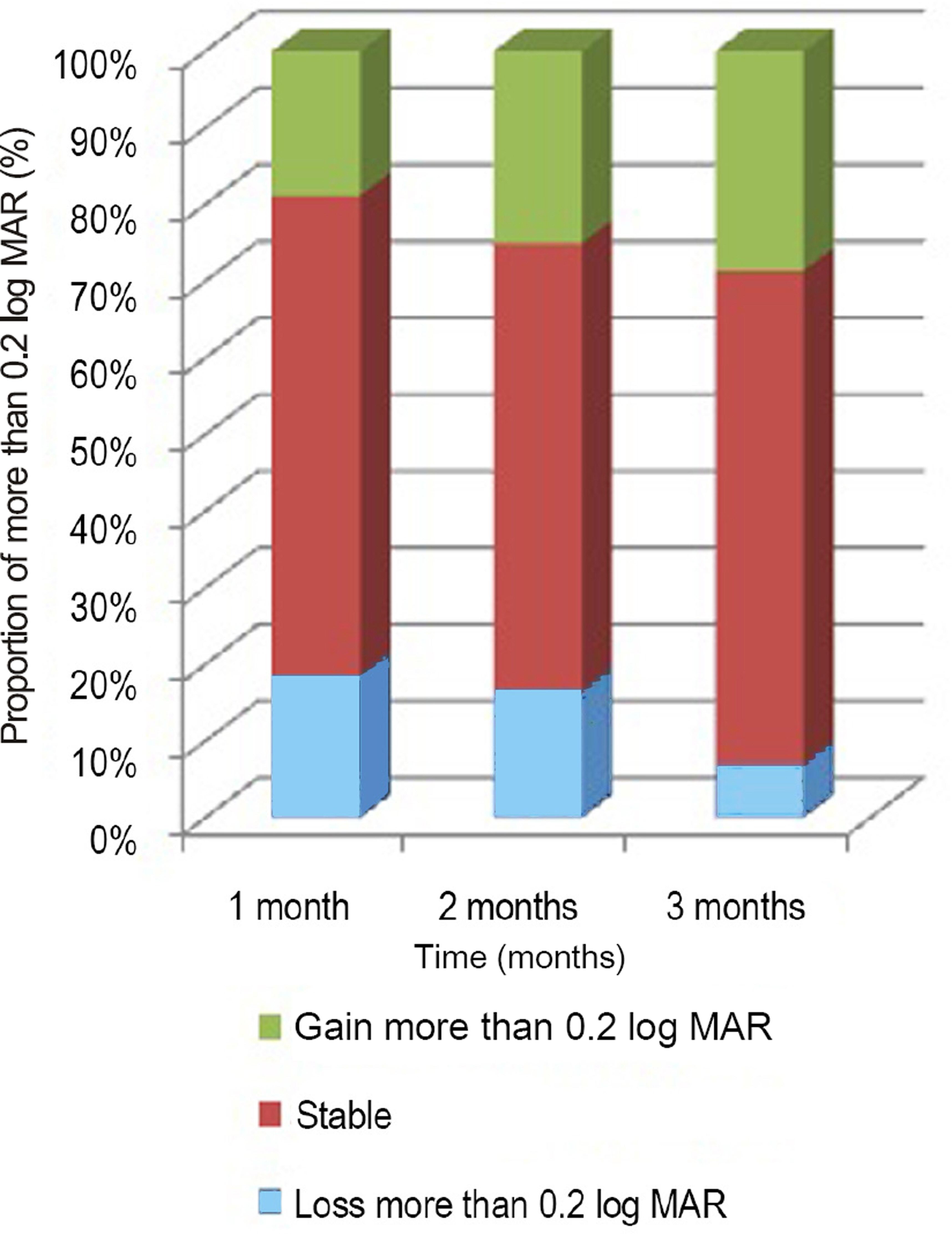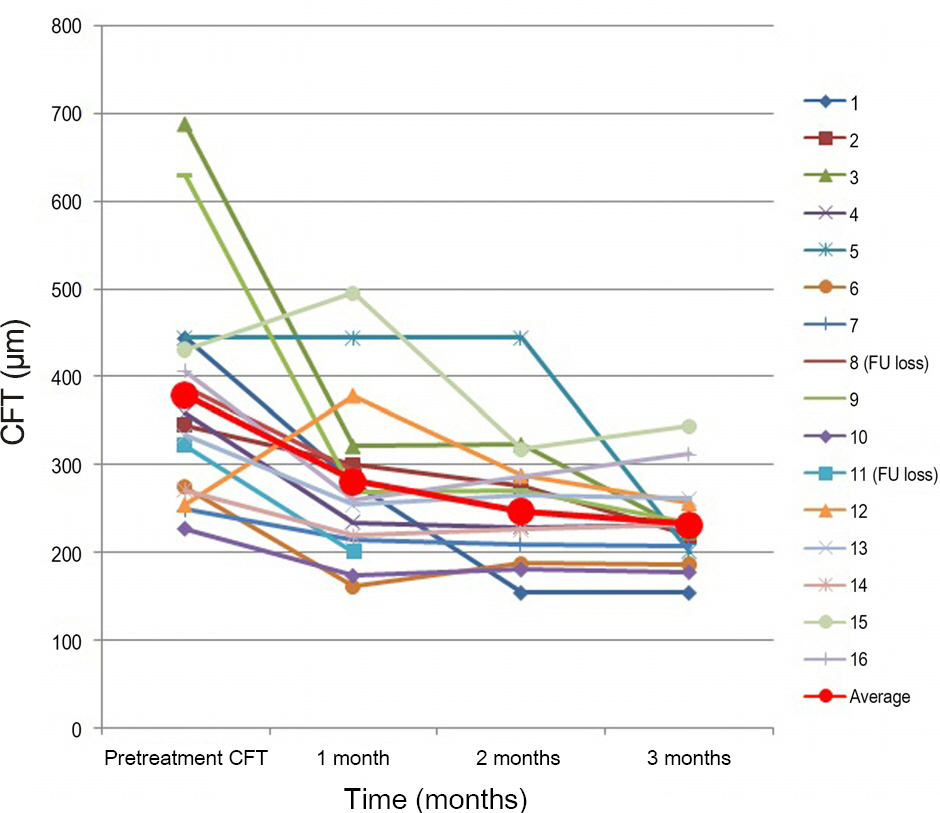J Korean Ophthalmol Soc.
2015 Nov;56(11):1728-1735. 10.3341/jkos.2015.56.11.1728.
Short-Term Efficacy of Intravitreal Aflibercept for Polypoidal Choroidal Vasculopathy
- Affiliations
-
- 1Sungmo Eye Hospital, Busan, Korea. choiooseok@hanmail.net
- KMID: 2214181
- DOI: http://doi.org/10.3341/jkos.2015.56.11.1728
Abstract
- PURPOSE
To evaluate the short-term effect of intravitreal aflibercept (Eylea(R); Regeneron Pharmaceuticals Inc., Tarrytown, NY, USA and Bayer, Basel, Switzerland) on the visual outcomes and retinal anatomic changes of patients with polypoidal choroidal vasculopathy (PCV).
METHODS
Intravitreal Eylea(R) was injected into 16 eyes of 16 patients with PCV in this retrospective case study. After therapy, the patients were followed up for over 3 months. Changes in best-corrected visual acuity (BCVA) and central foveal thickness (CFT) using optical coherence tomography (OCT) and abnormal vasculature on indocyanine green angiography (ICGA) were evaluated.
RESULTS
The mean log MAR BCVA was 0.75 +/- 0.60 at baseline, 0.74 +/- 0.60 and 0.71 +/- 0.63 at 1 and 2 months, respectively (p > 0.05) and 0.57 +/- 0.53 at 3 months (p < 0.05) after treatment. The mean CFT was 379 +/- 130 microm at baseline, 281 +/- 92 microm, 247 +/- 54 microm, and 231 +/- 51 microm at 1, 2, and 3 months, respectively, after treatment (p < 0.05). Complete resolution was 43%, 55%, and 50% at 1, 2, and 3 months, respectively in pigment epithelial detachment (PED), 67%, 83%, and 92% at 1, 2, and 3 months, respectively in subretinal fluid (SRF) and 33%, 60%, and 60% at 1, 2, and 3 months, respectively in intraretinal fluid (IRF) using OCT. The polypoidal lesions in ICGA decreased in 12 of 14 eyes (86%).
CONCLUSIONS
Intravitreal injection of Eylea(R) with PCV reduced CFT due to decreased retinal PED, SRF, IRF and occluded effectively the polypoidal lesion leaking. Compared with baseline, mean BCVA at the 3-month follow-up was significantly improved.
MeSH Terms
Figure
Cited by 1 articles
-
Long-term Treatment Outcome of Intravitreal Aflibercept Monotherapy for Polypoidal Choroidal Vasculopathy
Ye Ji Kim, Sang Yun Han, Jong Woo Kim, Chul Gu Kim, Dong Won Lee, Jae Hui Kim
J Korean Ophthalmol Soc. 2018;59(3):238-245. doi: 10.3341/jkos.2018.59.3.238.
Reference
-
References
1. Yannuzzi LA, Sorenson J, Spaide RF, Lipson B. Idiopathic poly-poidal choroidal vasculopathy (IPCV). Retina. 1990; 10:1–8.
Article2. Ciardella AP, Donsoff IM, Huang SJ. . Polypoidal choroidal vasculopathy. Surv Ophthalmol. 2004; 49:25–37.
Article3. Uyama M, Matsubara T, Fukushima I. . Idiopathic polypoidal choroidal vasculopathy in Japanese patients. Arch Ophthalmol. 1999; 117:1035–42.
Article4. Uyama M, Wada M, Nagai Y. . Polypoidal choroidal vasculop-athy: natural history. Am J Ophthalmol. 2002; 133:639–48.5. Lee WK, Kwon SI. Polypoidal choroidal vasculopathy. J Korean Ophthalmol Soc. 2000; 41:2573–84.6. Scassellati-Sforzolini B, Mariotti C, Bryan R. . Polypoidal choroidal vasculopathy in Italy. Retina. 2001; 21:121–5.
Article7. Lafaut BA, Leys AM, Snyers B. . Polypoidal choroidal vascul-opathy in Caucasians. Graefes Arch Clin Exp Ophthalmol 2000; 238. 752–9.
Article8. Yannuzzi LA, Wong DW, Sforzolini BS. . Polypoidal choroi-dal vasculopathy and neovascularized age-related macular degen-eration. Arch Ophthalmol. 1999; 117:1503–10.
Article9. Sho K, Takahashi K, Yamada H. . Polypoidal choroidal vascul-opathy: incidence, demographic features, and clinical characte-ristics. Arch Ophthalmol. 2003; 121:1392–6.10. Wen F, Chen C, Wu D, Li H. Polypoidal choroidal vasculopathy in elderly Chinese patients. Graefes Arch Clin Exp Ophthalmol. 2004; 242:625–9.
Article11. Byeon SH, Lee SC, Oh HS. . Incidence and clinical patterns of polypoidal choroidal vasculopathy in Korean patients. Jpn J Ophthalmol. 2008; 52:57–62.
Article12. Rosa RH Jr, Davis JL, Eifrig CW. Clinicopathologic reports, case reports, and small case series: clinicopathologic correlation of idio-pathic polypoidal choroidal vasculopathy. Arch Ophthalmol. 2002; 120:502–8.13. Kuroiwa S, Tateiwa H, Hisatomi T. . Pathological features of surgically excised polypoidal choroidal vasculopathy membranes. Clin Experiment Ophthalmol. 2004; 32:297–302.
Article14. Yuzawa M, Mori R, Kawamura A. The origins of polypoidal cho-roidal vasculopathy. Br J Ophthalmol. 2005; 89:602–7.
Article15. Tong JP, Chan WM, Liu DT. . Aqueous humor levels of vas-cular endothelial growth factor and pigment epithelium-derived factor in polypoidal choroidal vasculopathy and choroidal neovascularization. Am J Ophthalmol. 2006; 141:456–62.
Article16. Matsuoka M, Ogata N, Otsuji T. . Expression of pigment epi-thelium derived factor and vascular endothelial growth factor in choroidal neovascular membranes and polypoidal choroidal vasculopathy. Br J Ophthalmol. 2004; 88:809–15.
Article17. Cho HJ, Kim JW, Lee DW. . Intravitreal bevacizumab and ranibizumab injections for patients with polypoidal choroidal vasculopathy. Eye (Lond). 2012; 26:426–33.
Article18. Cho HJ, Baek JS, Lee DW. . Short-term effectiveness of intravitreal bevacizumab vs. ranibizumab injections for patients with polypoidal choroidal vasculopathy. Korean J Ophthalmol. 2012; 26:157–62.
Article19. Inoue M, Arakawa A, Yamane S, Kadonosono K. Short-term effi-cacy of intravitreal aflibercept in treatment-naive patients with pol-ypoidal choroidal vasculopathy. Retina. 2014; 34:2178–84.
Article20. Yuzawa M, Mori R, Haruyama M. A study of laser photocoagul-ation for polypoidal choroidal vasculopathy. Jpn J Ophthalmol. 2003; 47:379–84.
Article21. Lee SC, Seong YS, Kim SS. . Photodynamic therapy with ver-teporfin for polypoidal choroidal vasculopathy of the macula. Ophthalmologica. 2004; 218:193–201.
Article22. Lee PY, Kim KS, Lee WK. Photodynamic therapy with verteporfin in polypoidal choroidal vasculopathy. J Korean Ophthalmol Soc. 2004; 45:216–27.23. Silva RM, Figueira J, Cachulo ML. . Polypoidal choroidal vas-culopathy and photodynamic therapy with verteporfin. Graefes Arch Clin Exp Ophthalmol. 2005; 243:973–9.
Article24. Gomi F, Sawa M, Sakaguchi H. . Efficacy of intravitreal bev-acizumab for polypoidal choroidal vasculopathy. Br J Ophthalmol. 2008; 92:70–3.
Article25. Kokame GT, Yeung L, Lai JC. Continuous anti-VEGF treatment with ranibizumab for polypoidal choroidal vasculopathy: 6-month results. Br J Ophthalmol. 2010; 94:297–301.
Article26. Stewart MW, Rosenfeld PJ. Predicted biological activity of intra-vitreal VEGF Trap. Br J Ophthalmol. 2008; 92:667–8.
Article27. Papadopoulos N, Martin J, Ruan Q. . Binding and neutraliza-tion of vascular endothelial growth factor (VEGF) and related li-gands by VEGF Trap, ranibizumab and bevacizumab. Angiogen-esis. 2012; 15:171–85.
Article28. Heier JS, Brown DM, Chong V. . Intravitreal aflibercept (VEGF trap-eye) in wet age-related macular degeneration. Ophthalmology. 2012; 119:2537–48.
Article29. Ijiri S, Sugiyama K. Short-term efficacy of intravitreal aflibercept for patients with treatment-naïve polypoidal choroidal vasculo-pathy. Graefes Arch Clin Exp Ophthalmol. 2015; 253:351–7.
Article30. Kawashima Y, Oishi A, Tsujikawa A. . Effects of aflibercept for ranibizumab-resistant neovascular age-related macular degen-eration and polypoidal choroidal vasculopathy. Graefes Arch Clin Exp Ophthalmol. 2014; Nov 13. [Epub ahead of print].
Article
- Full Text Links
- Actions
-
Cited
- CITED
-
- Close
- Share
- Similar articles
-
- Initial Factors Associated with Resistance to Intravitreal Aflibercept Injection in Polypoidal Choroidal Vasculopathy
- Long-term Treatment Outcome of Intravitreal Aflibercept Monotherapy for Polypoidal Choroidal Vasculopathy
- Association between Vortex Vein Engorgement and Treatment Outcomes of Intravitreal Aflibercept for Polypoidal Choroidal Vasculopathy
- Analysis of Efficacy of Intravitreal Aflibercept According to Subfoveal Choroidal Thickness in Polypoidal Choroidal Vasculopathy
- A Comparison of Efficacies of Aflibercept and Ranibizumab, Depending on the Angiographic Classification of Polypoidal Choroidal Vasculopathy






